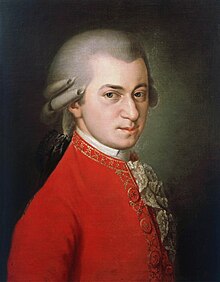Symphony No. 30 (Mozart)

Wolfgang Amadeus Mozart wrote Symphony No. 30 in D major, K. 202/186b[1] in Salzburg, completing it on 5 May 1774.
The work is scored for two oboes, two horns and two trumpets in D (silent in the Andantino and Trio), timpani and strings, but the timpani part has been lost.[2] There has been at least one attempt to reconstruct the timpani part.[3]
The work is in 4 movements:
- Molto allegro, 3
4 - Andantino con moto (A major), 2
4 - Menuetto and Trio (the latter in G major), 3
4 - Presto, 2
4
The first movement is in sonata form and opens with a falling, dotted fanfare motif.[4] A transitional section follows which contains a dialogue between violins and bass alternating between loud and soft dynamics and ending with a trill. The second theme a group of the sonata-form structure contains two sections. The first is a ländler scored for two violins against bass while the second is a minuet for the tutti featuring trills on almost every beat.[4] The expositional coda returns to the ländler style. The development focuses on the minuet style with the phrase-lengths elongated. Following the recapitulation, the movement coda returns to this minuet and regularizes its phrase lengths before the final cadence.[4]
In the trio of the minuet, the first violin is syncopated an eighth note ahead of the accompaniment.[4]
The finale starts with a falling dotted fanfare motif similar to the one that starts the opening movement. The answering phrase and the movement's second theme have a contradanse character.[4]
References
- ^ Ludwig Ritter von Köchel, Franz Giegling, Alexander Weinmann & Gerd Sievers, Chronologisch–thematisches Verzeichnis sämtlicher Tonwerke Wolfgang Amadé Mozarts, 6th ed. Wiesbaden: Breitkopf & Härtel (1964): 203.
- ^ Cliff Eisen, "Symphonies" The Mozart Conpendium, ed. H. C. Robbins Landon. London: Thames & Hudson (1990): p. 261
- ^ Robert Dearling. The Music of Wolfgang Amadeus Mozart: The Symphonies (Rutherford, Madison, Teaneck, Farleigh Dickinson University Press, 1982), p. 203: "A reconstructed timpani part is provided in which the timpani plays in each of the movements except the slow movement."
- ^ a b c d e Brown, A. Peter, The Symphonic Repertoire (vol. 2). Indiana University Press (ISBN 025333487X), pp. 379–381 (2002).
External links
- Symphony in D K. 202: Score and critical report (in German) in the Neue Mozart-Ausgabe
- Symphony No. 30: Scores at the International Music Score Library Project

